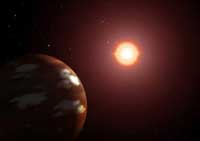Team of European Astronomers find first rocky planet outside solar system
Astronomers have found more than 300 planets outside our solar system but none of them have been proven to be solid until now. A team of European astronomers has confirmed that a planet discovered earlier this year about 500 light years away is more than a big gas ball. One of the scientists describes it "as close to something like the Earth" that's been found so far.

Scientists have long figured that for life to begin on a planet, it needs a solid surface to rest on. So, experts outside the team say finding such a planet is a big deal, The Associated Press reports.
In February 2009, the discovery by the CoRoT satellite of a small exoplanet around a rather unremarkable star named TYC 4799-1733-1 was announced one year after its detection and after several months of painstaking measurements with many telescopes on the ground, including several from ESO. The star, now known as CoRoT-7, is located towards the constellation of Monoceros (the Unicorn) at a distance of about 500 light-years. Slightly smaller and cooler than our Sun, CoRoT-7 is also thought to be younger, with an age of about 1.5 billion years.
Every 20.4 hours, the planet eclipses a small fraction of the light of the star for a little over one hour by one part in 3000. This planet, designated CoRoT-7b, is only 2.5 million kilometers away from its host star, or 23 times closer than Mercury is to the Sun. It has a radius that is about 80% greater than the Earth's, Scientific Frontline report.
When astronomers discovered COROT-7b in February, they couldn’t determine its mass because they didn’t have precise enough measurements of the velocity of its star. Now, using 70 hours of observation data from the High Accuracy Radial velocity Planet Searcher (HARPS) spectrograph, scientists from the European Southern Observatory have calculated that the exoplanet is only about five times more massive than Earth.
Combined with the planet’s known radius, which is almost twice that of Earth, the new mass measurement makes COROT-7b the first exoplanet with a known density similar to Earth’s.
Most exoplanets are gaseous giants that resemble Jupiter or Neptune. But if extraterrestrial life exists in the universe, Seager said we’re most likely to find it on a small, rocky exoplanet with a density similar to Earth. “The holy grail in exoplanets, and maybe in all of science, is to find another planet like Earth, a planet that has signs of life on it,” she said, reports Wired News.
Subscribe to Pravda.Ru Telegram channel, Facebook, RSS!





